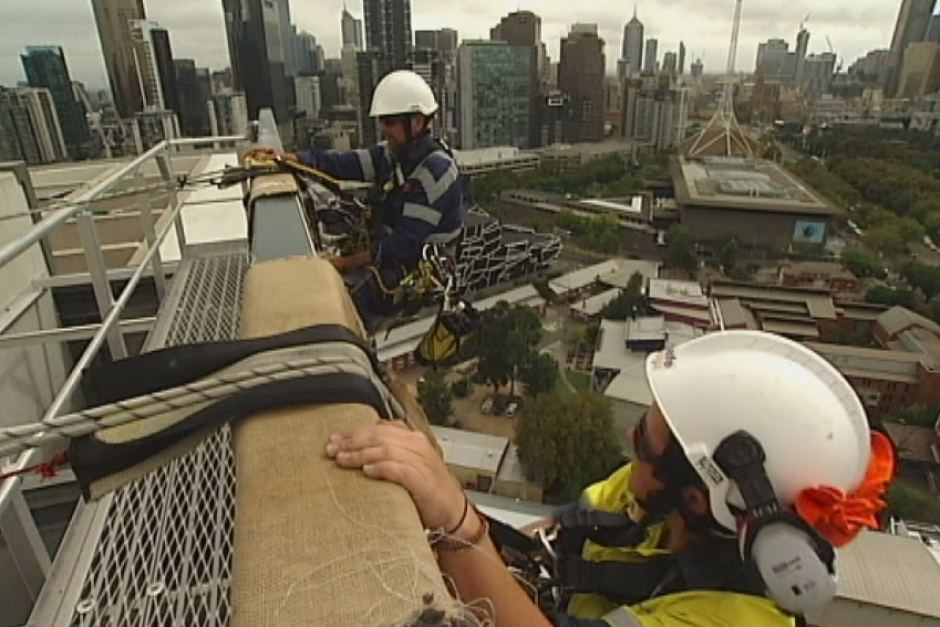Unions are calling for tougher safety regulations and enforcement to stop workers falling to their deaths at worksites, saying more people will be killed unless self-regulation is scrapped.
Falls from heights are a major cause of death and injury in Australian workplaces, according to Safe Work Australia.
Of the 800,000 Australians who work at heights, including tradesmen, cleaning, and maintenance workers, on average 26 of them fall to their death each year, and almost 8,000 are injured.

Working At Heights Association secretary Gordon Cadzow says regulators are not enforcing the safety standards.
"It's the second largest cause of death in industry," he said.
"There has to be a policeman and the policeman has to enforce the law.
"Falling from height, there's no second chance. I've been close to fatalities in the past and I don't want to get close to them again."
Worker's death could have been avoided, family says
In 2011, 45-year-old West Australian builder Bernard Wills was on his first day on a new job - a high shed under construction near Esperance - when he fell through a skylight to his death.
Late last year, Wills' employer was fined $65,000 for not following safety procedures.
His family believes his death could have been avoided if safety standards had been strictly policed by regulators.
"The failure to do these safety measures resulted in his death and that's why he isn't here today," his sister Theresa Curley said.
"I think that there's enough knowledgeable and experienced people within the whole industry, from the regulators right down, that can look at these problems with working at height risks and reduce the probability that someone who was so inexperienced would find themselves on that roof and have the opportunity to risk their life."
Lack of safety regulations likened to 'Wild West'
For those who work at heights, their lives literally depend on the ropes and anchors holding them up.
There is a certification system to ensure their safety, but it is hopelessly unreliable and unregulated, with abseil anchor points often left untested.
Peter Ferguson from the Australian Rope Access Association argues that people are being allowed to get away with not applying the rules.
"It's pointless having regulations if they aren't policed, and the policing just simply isn't happening at the moment," he said.
Gren Hinton from Proaccess window cleaning says safety checks of equipment and structures are hit and miss.
"Some of them will be tested, some of them won't be tested," he told 7.30.
"And there's no certification or accrediting body for the companies installing. You can't trust anything. It's basically the Wild West out there."
Engineer Clive Austin and his team were hired to carry out maintenance on a Melbourne apartment building.
They checked the abseiling anchors and found that, while they were certified, they were woefully faulty.
Mr Austin asked the building owners to replace the anchors. Instead, his company was replaced.
He reported this to the regulator, which did nothing because the replacement team had not started.
"We reported that to WorkSafe," Mr Austin said.
"They said they wouldn't investigate because it didn't constitute a building site."
When 7.30 put to Len Neist of the Victorian WorkCover authority that six workers required to do heavy maintenance on one site must surely constitute a workplace, he responded: "We have limited resources".
But Mr Austin says that is not good enough.
"There needs to be some sort of regulation to make sure that the anchors are safe," he said.
"We want to come home."
Mr Hinton told 7.30 he agrees.
"I'd like to see WorkCover or an accreditation body that actually did site inspections and the threat of penalties," he said.
Falls from ladders another big risk
Mr Cadzow says falls from ladders are another big risk.
"When we looked at ladders, over 90 per cent inspected were not to Australian standards," he said
"We've taken this data to the regulator and asked him to treat this as a serious matter. The response has been disappointing."
Plumber Keith Dickman was working up a ladder on a construction site in Melbourne when he fell and died.
In 2012, the Victorian Coroner's Court found the defective ladder and unsafe work practices contributed to his death.
Gary Roberts, Dickman's friend and fellow plumber, says Dickman should still be alive.
"If he had a correct ladder, it wouldn't have happened. He'd still be here," he said.
Mr Roberts accompanied Dickman's widow to the coronial inquest.
"[Keith's] wife died approximately three weeks after the handing down of the Coroner's report," he said.
"She didn't die of an illness, she died of heartbreak."
State regulators resisting calls to step up safety
Despite the deaths, state workplace regulators are resisting calls to step up policing of the working at heights sector.
Some are also coming under funding pressure.
Victoria's WorkCover scheme, which until recently was called WorkSafe, was regarded as the best safety regulator in Australia.
But the Victorian Government is stripping almost $500 million out of its budget.
Former WorkSafe chairman and director James Mackenzie warns that that is dangerous.
"It's not a magic pudding fund," he said.
"If you get $100 and you've got to look after injured workers with some of it, regulate and promote occupational health and safety with some of it, and pay a dividend to Government, you don't have enough money for the first two if you've got to pay the third."
Mr Neist denies that will affect WorkSafe's ability to expand enforcement.
But many are concerned that it will mean even less regulation in the future.
"There'll be other families that will be go through the same experience that we have," Theresa Curley said.
"I think the cycle will continue and there'll be no end really."
Source: ABC News
Links: Working At Heights Association, Working at heights Courses, Ladder Safety



